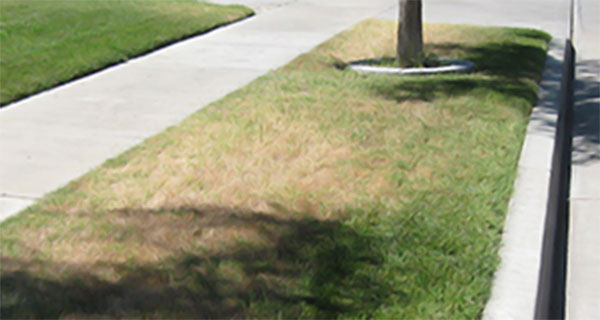Alternate Landscaping of Parkway Strips

Listed below are some alternative ways to landscape the parkway strip located in front of your residence (if applicable) to reduce water use and maintenance. The parkway strip is that portion of the roadway right-of-way located between the sidewalk and the curb. The strip is intended to be landscaped. Often times the required City street tree will also be located there.
Applicability
- This policy applies only to replacement and rehabilitation of existing parkway landscape located within the public right-of-way by a single homeowner. It does not apply to new subdivisions or new construction of landscapes that may be subject to other City laws and regulations.
- This policy does not apply to any residential property with an approved landscape plan (or that is required to obtain City approval of the landscape plan) that includes the parkway strip area. Generally, this includes residential properties zoned Planned Development and multi-family properties (more than 2 dwelling units on a lot).
- This policy does not apply to commercial or industrial zoned or used property.
Reviewing Department
Parks, Recreation and Public Facilities DivisionDetermination
Property owners may plant the following in the parkway strip area:- Required street tree (type determined by the City and maintained according to City Ordinance)
- Natural Grass (including drought-tolerant "no mow" varieties)
- Artificial Turf
- Shrubs (not to exceed 36 inches in height)
- Groundcover (low-lying, including annuals)
The following materials may not be used in the parkway strip area:
- Gravel
- River Rock
- Cobble
- Concrete
- Asphalt
- Brick
- Any material that may create a slipping or tripping hazard

The only exceptions to the restrictions listed above are as follows:
- The property owner may construct a concrete mow strip of not greater than 4 inches in width around the base of the street tree to improve irrigation. The mow strip needs to be of sufficient size (diameter) to ensure that the tree is not damaged and its growth is not impaired. This size varies by the type of tree.
- Brick pathways may be installed between the curb and the sidewalk to facilitate pedestrian movement between parked vehicles and the sidewalk, when natural plant materials, such as grass, shrubs or groundcovers are used. The brick pathways shall be installed with sand only and must meet ASTM International standards for Pedestrian and Light Traffic Paving Brick. Pavers shall be set with sand only. The pathway must be at least 4 feet wide and shall not occupy more than 30% of the parkway strip area. The brick pathway shall not be located closer than 3 feet to a tree trunk or the connection of the driveway approach to the sidewalk, and should be located in such a manner as to correspond with vehicle door openings. Brick pathways shall not be allowed where the adjacent street parking area is less 20' in length (i.e., is not adequate in length to allow a vehicle to park).
For more information on alternate landscape designs and/or irrigation practices for your home or business, visit:
Save Our Water
California Department of Water Resources, Water Efficient Landscaping
Be Water Wise


